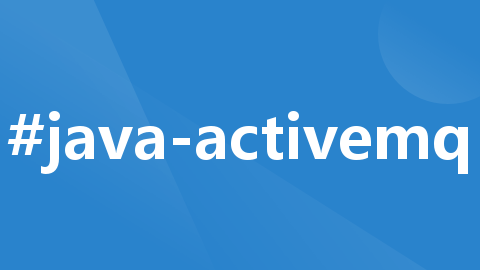
Springboot整合ActiveMQ(Queue和Topic两种模式)
Apache ActiveMQ是Apache软件基金会所研发的开放源代码消息中间件;由于ActiveMQ是一个纯Java程序,因此只需要操作系统支持Java虚拟机,ActiveMQ便可执行。
写在前面: 从2018年底开始学习SpringBoot,也用SpringBoot写过一些项目。这里对学习Springboot的一些知识总结记录一下。如果你也在学习SpringBoot,可以关注我,一起学习,一起进步。
相关文章:
【Springboot系列】Springboot入门到项目实战
文章目录
ActiveMQ简介
1、ActiveMQ简介
Apache ActiveMQ是Apache软件基金会所研发的开放源代码消息中间件;由于ActiveMQ是一个纯Java程序,因此只需要操作系统支持Java虚拟机,ActiveMQ便可执行。
2、ActiveMQ下载
下载地址:http://activemq.apache.org/components/classic/download/

下载完成后解压双击activemq.bat文件打开(不用安装,直接使用),目录和打开后效果如下:


运行后,浏览器访问http://localhost:8161/地址进入一下界面。

点击Manage ActiveMQ broker登录到ActiveMQ管理页面,默认账号和密码都是admin。管理页面如下:

SpringBoot整合ActiveMQ
1、新建SpringBoot项目
新建Springboot项目,添加对应的依赖。项目完整的pom.xml文件如下:
<?xml version="1.0" encoding="UTF-8"?>
<project xmlns="http://maven.apache.org/POM/4.0.0" xmlns:xsi="http://www.w3.org/2001/XMLSchema-instance"
xsi:schemaLocation="http://maven.apache.org/POM/4.0.0 https://maven.apache.org/xsd/maven-4.0.0.xsd">
<modelVersion>4.0.0</modelVersion>
<parent>
<groupId>org.springframework.boot</groupId>
<artifactId>spring-boot-starter-parent</artifactId>
<version>2.2.5.RELEASE</version>
<relativePath/> <!-- lookup parent from repository -->
</parent>
<groupId>com.mcy</groupId>
<artifactId>springboot-mq</artifactId>
<version>0.0.1-SNAPSHOT</version>
<name>springboot-mq</name>
<description>Demo project for Spring Boot</description>
<properties>
<java.version>1.8</java.version>
</properties>
<dependencies>
<dependency>
<groupId>org.springframework.boot</groupId>
<artifactId>spring-boot-starter-web</artifactId>
</dependency>
<!--Activemq依赖-->
<dependency>
<groupId>org.springframework.boot</groupId>
<artifactId>spring-boot-starter-activemq</artifactId>
</dependency>
<dependency>
<groupId>org.springframework.boot</groupId>
<artifactId>spring-boot-starter-test</artifactId>
<scope>test</scope>
<exclusions>
<exclusion>
<groupId>org.junit.vintage</groupId>
<artifactId>junit-vintage-engine</artifactId>
</exclusion>
</exclusions>
</dependency>
</dependencies>
<build>
<plugins>
<plugin>
<groupId>org.springframework.boot</groupId>
<artifactId>spring-boot-maven-plugin</artifactId>
</plugin>
</plugins>
</build>
</project>
2、项目结构
3、相关配置信息
在application.properties类中添加ActiveMQ相关的配置信息
server.port=8080
server.servlet.context-path=/mq
#MQ服务器地址
spring.activemq.broker-url=tcp://localhost:61616
#用户名
spring.activemq.user=admin
#密码
spring.activemq.password=admin
#设置是Queue队列还是Topic,false为Queue,true为Topic,默认false-Queue
spring.jms.pub-sub-domain=false
#spring.jms.pub-sub-domain=true
#变量,定义队列和topic的名称
myqueue: activemq-queue
mytopic: activemq-topic
4、ActiveMQ配置类
ActiveMQ配置类ConfigBean,配置了Queue队列和topic两种模式,代码如下:
import org.apache.activemq.command.ActiveMQQueue;
import org.apache.activemq.command.ActiveMQTopic;
import org.springframework.beans.factory.annotation.Value;
import org.springframework.context.annotation.Bean;
import org.springframework.jms.annotation.EnableJms;
import org.springframework.stereotype.Component;
import javax.jms.Topic;
/**
1\. MQ配置类
*/
@Component
@EnableJms
public class ConfigBean {
@Value("${myqueue}")
private String myQueue;
@Value("${mytopic}")
private String topicName;
//队列
@Bean
public ActiveMQQueue queue(){
return new ActiveMQQueue(myQueue);
}
//topic
@Bean
public Topic topic(){
return new ActiveMQTopic(topicName);
}
}
Queue队列模式
队列模式即点对点传输。
点对点消息传递域的特点如下:
- 每个消息只能有一个消费者,类似于1对1的关系。好比个人快递自己领自己的。
- 消息的生产者和消费者之间没有时间上的相关性。无论消费者在生产者发送消息的时候是否处于运行状态,消费者都可以提取消息。好比我们的发送短信,发送者发送后不见得接收者会即收即看。
- 消息被消费后队列中不会再存储,所以消费者不会消费到已经被消费掉的消息。
1、队列生产者
QueueProducerController类为队列生产者控制器,主要向消息队列中发送消息。代码如下:
import org.springframework.beans.factory.annotation.Autowired;
import org.springframework.jms.core.JmsMessagingTemplate;
import org.springframework.web.bind.annotation.RequestMapping;
import org.springframework.web.bind.annotation.RestController;
import javax.jms.Queue;
/*
* 队列消息生产者
*/
@RestController
public class QueueProducerController {
@Autowired
private JmsMessagingTemplate jmsMessagingTemplate;
@Autowired
private Queue queue;
/*
* 消息生产者
*/
@RequestMapping("/sendmsg")
public void sendmsg(String msg) {
System.out.println("发送消息到队列:" + msg);
// 指定消息发送的目的地及内容
this.jmsMessagingTemplate.convertAndSend(this.queue, msg);
}
}
2、队列消费者
QueueConsumerController类为队列消费者控制器,具体代码如下:
import org.springframework.beans.factory.annotation.Value;
import org.springframework.jms.annotation.JmsListener;
import org.springframework.web.bind.annotation.RestController;
/*
1\. 队列queue消费者控制器
*/
@RestController
public class QueueConsumerController {
/*
* 消费者接收消息
*/
@JmsListener(destination="${myqueue}")
public void readActiveQueue(String message) {
System.out.println("接受到:" + message);
}
}
3、测试效果
运行项目在浏览器中访问http://localhost:8080/mq/sendmsg?msg=123。向消息队列中发送123。控制台输出效果:

ActiveMQ控制台显示:

- Number Of Pending Messages:消息队列中待处理的消息
- Number Of Consumers:消费者的数量
- Messages Enqueued:累计进入过消息队列的总量
- Messages Dequeued:累计消费过的消息总量
【注】队列模式时,配置文件application.properties中spring.jms.pub-sub-domain属性必须设置为false。
Topic模式
topic模式基于发布/订阅模式的传输。
基于发布/订阅模式的传输的特点如下:
- 生产者将消息发布到topic中,每个消息可以有多个消费者,属于1:N的关系;
- 生产者和消费者之间有时间上的相关性。订阅某一个主题的消费者只能消费自它订阅之后发布的消息。
- 生产者生产时,topic不保存消息它是无状态的不落地,假如无人订阅就去生产,那就是一条废消息。
1、topic生产者
TopicProducerController类为topic生产者控制器,主要向消息队列中发送消息。代码如下:
import org.springframework.beans.factory.annotation.Autowired;
import org.springframework.jms.core.JmsMessagingTemplate;
import org.springframework.web.bind.annotation.RequestMapping;
import org.springframework.web.bind.annotation.RestController;
import javax.jms.Queue;
import javax.jms.Topic;
/*
* topic消息生产者
*/
@RestController
public class TopicProducerController {
@Autowired
private JmsMessagingTemplate jmsMessagingTemplate;
@Autowired
private Topic topic;
/*
* 消息生产者
*/
@RequestMapping("/topicsendmsg")
public void sendmsg(String msg) {
System.out.println("发送消息到MQ:" + msg);
// 指定消息发送的目的地及内容
this.jmsMessagingTemplate.convertAndSend(this.topic, msg);
}
}
2、topic消费者
TopicConsumerController类为topic消费者控制器,其中写了两个消费者方法,可以理解为有两个用户订阅。具体代码如下:
import org.springframework.jms.annotation.JmsListener;
import org.springframework.web.bind.annotation.RestController;
/*
1\. topic消费者控制器
*/
@RestController
public class TopicConsumerController {
/*
* 消费者接收消息
*/
@JmsListener(destination="${mytopic}")
public void readActiveQueue(String message) {
System.out.println("接受到:" + message);
}
@JmsListener(destination="${mytopic}")
public void readActiveQueue1(String message) {
System.out.println("接受到:" + message);
}
}
3、测试效果
运行项目在浏览器中访问http://localhost:8080/mq/topicsendmsg?msg=123。向消息队列中发送123。控制台输出效果(有两个消费者方法):

ActiveMQ控制台显示:

- Number Of Consumers:消费者的数量
- Messages Enqueued:累计进入过消息队列的总量
- Messages Dequeued:累计消费过的消息总量
【注】Topic模式时,配置文件application.properties中spring.jms.pub-sub-domain属性必须设置为true。
最后有什么不足之处,欢迎大家指出,期待与你的交流。如果感觉对你有帮助,点个赞在走呗 O(∩_∩)O ~

开放原子开发者工作坊旨在鼓励更多人参与开源活动,与志同道合的开发者们相互交流开发经验、分享开发心得、获取前沿技术趋势。工作坊有多种形式的开发者活动,如meetup、训练营等,主打技术交流,干货满满,真诚地邀请各位开发者共同参与!
更多推荐
 已为社区贡献6条内容
已为社区贡献6条内容





所有评论(0)